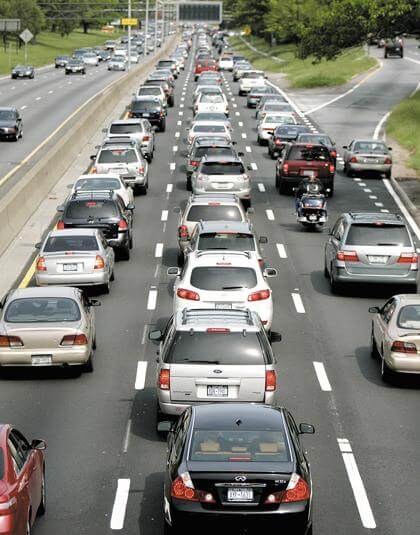By Stephen Stirling and Jeremy Walsh
The “pricing” may have been taken away from the congestion debate, but traffic tie-ups on Queens roadways remain a boroughwide problem with few, if any, solutions on the immediate horizon.
According to data from the U.S. Census' 2006 American Community Survey, Queens has one of the longest commutes in the nation at 41.8 minutes.
While census figures show most of the borough's work force does use mass transit, more than 400,000 Queens residents still take to the roads each day and many say it is all too often an unpleasant experience.
“It's a nightmare everyday. Every single day,” said Bill Harrison, a Fresh Meadows resident. “You're on the roads near where those highways come together and forget about it.”
The borough also has an influx of more than 125,000 drivers from Brooklyn and Nassau counties and several thousand more from other boroughs and neighboring New Jersey and Connecticut, according to the 2006 census data.
“My job requires me to go from Corona down to Jamaica a few times a week and I've gotta plan an extra 15 minutes at least into my trip. If I didn't, I'd be out of a job,” Harrison said.
Some 51,681 Queens residents drive to work in Manhattan, more than any other borough or outlying area except New Jersey, the census data showed. The number also accounts for 14.6 percent of Queens residents working in Manhattan.
With a large portion of Queens' work force heading into Manhattan each day, borough roadways and the river crossings are often clogged long before commuters cross the bridges into Manhattan.
Queens elected officials and community leaders have long said the reason for borough residents driving to work in such large numbers can be directly attributed to a lack of available public transportation. Direct routes to Manhattan, particularly in eastern Queens, are limited in the borough as are public transportation routes from north to south.
Despite frustrations with the Metropolitan Transportation Authority, however, Jackson Heights resident and No. 7 train commuter Denise O'Shea said the subway is still miles ahead of the alternative: driving.
“If I think the 7 train is erratic, the traffic is even more erratic,” said O'Shea, who owns a car. “I just don't like the stress of driving in traffic. Driving to work, that's something that would never even occur to me.”
Queens' traffic woes are compounded in several hot spots, where road congestion has caused an outcry among local leaders.
The borough's East River crossings are some of the busiest routes into Manhattan. According to city Department of Transportation figures recorded in 2005 and released in 2007, some 87,635 trips into Manhattan were made each day on the Queensborough Bridge. The Triborough Bridge had the next highest number, with 50,819 daily trips. The Queens-Midtown Tunnel had 46,309 daily trips into the city. In total, the DOT tracked 184,763 trips to Manhattan each day from Queens.
Queens also boasts one of the largest highway systems in the city. Major roadways like the Van Wyck Expressway, Grand Central Parkway and Long Island Expressway often grind to a halt during the morning and evening commute.
Queens' major throughways are not likely to see any boost in capacity in the near future, either. In an interview with the TimesLedger, city DOT Commissioner Janette Sadik-Khan said there were no plans to add new roads or lanes to existing highways.
“What we've seen is when you build additional roadways, the capacity is instantly taken up,” she said.
Off the highways, western Queens faces major traffic backups from people diverting between the three East River crossings and major parking problems from commuters who leave their cars to take mass transit to Manhattan.
Joe Conley, chairman of Long Island City's Community Board 2, said parking and traffic congestion are a major problem at the corner of Queens Boulevard and Jackson Avenue and at the intersection of Crescent Street, the Queensboro Bridge and Northern Boulevard.
Still, Conley said he opposed Mayor Michael Bloomberg's congestion pricing plan, which would have charged drivers $8 to enter Manhattan below 60th Street during business hours.
“There are much better ways to get traffic off the street,” he said. “Right after Sept. 11, we were not seeing the traffic problems because there was a ban on single occupancy cars into Manhattan. We could also implement carpooling requirements during rush hour. There have been so many recommendations that have come out that have been ignored.”
Downtown Flushing is home to another major traffic snarl. State Assemblywoman Ellen Young (D-Flushing) called the area the largest transit hub outside Manhattan with the accompanying congestion problems.
“There are more than two dozen bus lines that constantly run through downtown Flushing,” she said, noting that traffic from four major highways pours onto Flushing surface streets near the Long Island Rail Road's busy Flushing-Main Street station and the final stop of the only subway line in northeast Queens, the No. 7 train.
“While this is an express stop, straphangers are still not guaranteed a seat due to overcrowding,” she said of the No. 7 line.
Jackson Heights is another western Queens neighborhood with a glut of traffic and not enough parking.
Will Sweeney, the Western Jackson Heights Alliance president, said the network of streets intersecting 37th Avenue is a source of constant gridlock and misery.
He pointed out that “73rd Street is the only street that connects Northern Boulevard, Roosevelt Avenue and Broadway — 72nd, 74th and 75th [streets] are routed north. Residents [on 73rd Street] basically deal with traffic seven days a week, at a minimum of 12 hours a day.”
Sadik-Kahn said the answer to Queens' and the city's traffic woes are major upgrades to public transportation.
“We're talking about 13 days a year that people are spending in their cars,” she said. “I would argue that there are a lot better uses of that time.”
But with the death of congestion pricing, a lack of new fund-generating proposals and the MTA expected to face more than $1 billion in deficits in the coming years, Queens drivers may want to pencil those 13 days into their schedule for the foreseeable future.
Reach reporters Stephen Stirling and Jeremy Walsh by e-mail at news@timesledger.com.


































